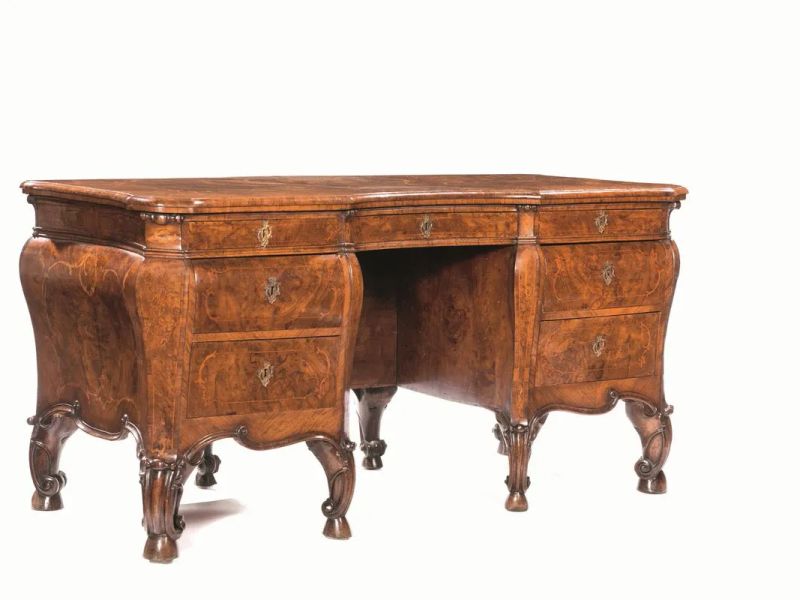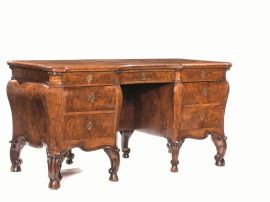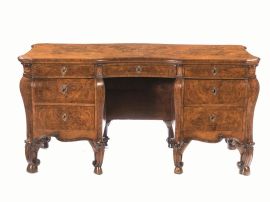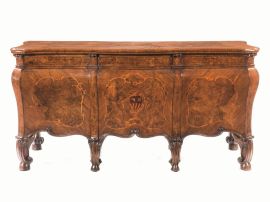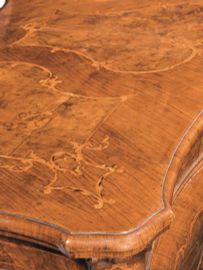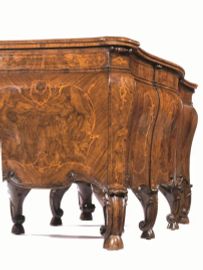RARE CENTRE DESK, LOMBARDY, THIRD QUARTER OF THE 18TH CENTURY
RARE CENTRE DESK, LOMBARDY, THIRD QUARTER OF THE 18TH CENTURY
Veneered chestnut and chestnut briar, rounded shape, four large drawers with an additional three on the side, standing on eight feet made of carved chestnut, 84x164x77 cm
Lombardy’s passage from Spanish to Austrian rule determined not only a change in the Duchy’s borders, but also an evolution in taste, with a progressive abandonment of baroque in favour of the newer rococo style, which was immediately adopted in the estates of the most important Lombard families of the time, such as the Borromeo, the Litta, the Sormani, and the Clerici. Internationally renowned artists were summoned to Lombardy, spreading rocaille-style decoration among their rich Lombard customers. This style of decoration was already popular with architects and decorators on the other side of the Alps, and is characterized by the indented and sinuous lines used to frame pictures. This à cartouche motif became the chief characteristic of Lombard rococo and was employed by most of the artists and decorators of the time. This included the local master woodcarvers, who added to the typical black-frame Lombard decoration a novel division of the piece of furniture into elegant panes embellished with refined rocaille inlays, inspired by similar French and German models, and thus gave these furnishings a more international feel. Among the major interpreters of this style we can mention Pietro Canevesi, Giuseppe Colombo, also known as “Mortarino” (fig. 1) Pietro Antonio Mezzanotti, as well as a very young Giuseppe Maggiolini.
It is then within this cultural and artistic context that we are to place this centre desk, which, given its size, proportions, and uniqueness, was doubtless crafted by a master woodcarver for a rich Lombard family. A prelude to the lot presented here can be seen in the desk from the first half of the 18th century which comes from Villa Borromeo d’Adda in Arcore (published by Clelia Alberici in Il mobile lombardo – fig.2), which features a frontal division into three etched panes.
This desk rests upon eight robust feet, finely carved into intertwined scrolls, out of which grow eight rounded uprights, which soften the desk by ridding it of sharp angles, and which end with elegant curls onto which rests the table itself, contoured and with bird’s beak styled rimming. Built in an “a cattedra” shape, this desk features four large drawers, as well as three smaller ones on the side, and is decorated with elegant inlaid panes on all sides, on the legs, and on the plane of the table, framing the chestnut briar root in the larger spaces whilst decorating the smaller ones. These inlays, made of bosswood and styled into fringed rocailles, derive from Lombard “turnip-skin” style decoration and originating in Austria and Germany. On the centre-front, the desk features a blazon which without doubt belonged to its original acquirer.
Comparative literature
C. Alberici, Il mobile lombardo, Milano 1969, p. 102;
R. Bossaglia, V. Terraroli, Settecento lombardo, Milano 1991, V.26

